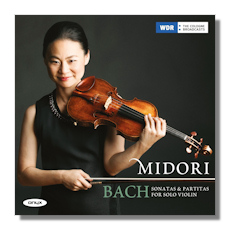
The Internet's Premier Classical Music Source
Related Links
-
Bach Reviews
- Latest Reviews
- More Reviews
-
By Composer
-
Collections
DVD & Blu-ray
Books
Concert Reviews
Articles/Interviews
Software
Audio
Search Amazon
Recommended Links
Site News
 CD Review
CD Review
Johann Sebastian Bach

Sonatas & Partitas for Solo Violin
- Sonata I in G minor, BWV 1001
- Partita I in B minor, BWV 1002
- Sonata II in A minor, BWV 1003
- Partita II in D minor, BWV 1004
- Sonata III in C Major, BWV 1005
- Partita III in E Major, BWV 1006
Midori, violin
Onyx Classics ONYX4123 2CDs 136:03
There are about 150 recordings of Bach's Sonatas and Partitas for solo violin, BWV 1001-1006, currently available. This release on WDR's Onyx label of two CDs lasting just over 66 and 69 minutes was made in August 2013 at the Klaus von-BISmarck-Saal, Funkhaus in Cologne in the order first sonata (G minor) - first partita (B minor), second sonata (A minor) - second partita (D minor), third sonata (C Major) - third partita (E Major) – in other words in the sequence of the BWVs.
In her booklet note, the Japanese Midori Gotō, who was born in 1971, tells of her very early familiarity with these works, pinnacles of the repertoire… after all, her mother was her teacher. One is very soon left in no doubt that they are second nature to her. Deftness, attack, total control – technical competence – are all evident from the very start. And so is carefully-controlled expression. These works are so rich and profound that there is surely room for almost anyone's sense of what they communicate, and how they do so.
Yet, given that there are so many superb recordings already available, whose strong points range from the envelopingly romantic to the starkly pared down – from Grumiaux on Philips (000701002), say, to Podger on Channel Classics (24982); or the classic Milstein on DG ("The Originals" 457701) – there really should be a compelling reason for a new one. In Midori's case she is striking a balance which for some will be welcome: it's between technical competence (these are demanding works) and a second balance that seeks to avoid both blandness and intensity.
The result is that the performances are not exactly "safe"; but neither are they adventurous or striking. At the same time, oddly, they are gripping. They sail sufficiently far from the shore as to demand attention: tempi are measured but not pedestrian; phrasing is generous but not languorous; and the tone of the violin is not reduced, or routine. Neither is it noticeably distinguished. Midori's playing is far from "stale". Yet it veers a little towards a slowly unrolling gesture which shows how familiar she is with the music. Since she identifies with it as something she has known almost all her life, that's both understandable and forgivable.
But at the same time, there is a lack of spark, of true panache or compulsion. Midori's reading intrigues by the very evidence of a striving not to sound eccentric or too "different". If the result were lack of character or a mundane performance, the recording would have little to recommend it. In a curious way, though, it does have something to offer. The life that has been breathed into these accounts surely comes from Midori's conviction that one can only truly understand them by appreciating that nothing in them is static, that one gets closer to their essence in the very act of pursuing it. And that is what she does: while one cannot hear the cogs grinding, one is aware of the effort being put into production… the momentum of the A minor Fugue, BWV1003 [CD.1 tr.14], is too mechanical – as the pace of the andante which follows it.
The result is that these are relatively "independent" performances. This is not to say that Midori's playing is wayward or eccentric. Nor that she makes any undue attempt to project her own individuality and suredness of approach above the music itself. Rather, that her approach seems to have little or no need to conform to others' visions, or even to rest on her own perception of the music one, five, ten or twenty years ago. This is what intrigues. Mild roughness, slight lack of elegance, unexpectedly dragging tempi at times all combine with her impeccable grasp of intonation to draw us in. We stay involved and captivated. But we do ask questions while listening. For instance, we ask, "Could these be revelatory performances if listened to often enough?"
That this question can even be plausible is testament to the quality of the CDs. Midori's account is not groundbreaking. But it will do more than satisfy many for its freshness, confidence and insight. The acoustic is excellent and aids the immediacy of the instrument and projection of the playing very well. Midori's narrative of her relationships with the works in the four page essay in the booklet is not solipsistic, but illuminating. This may not be everyone's first choice; but it has an undeniable appeal that seems unlikely to pall.
Copyright © 2016, Mark Sealey





















